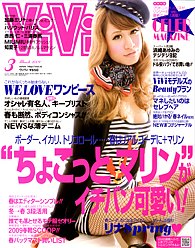Chokotto marin
Fashion magazine ViVi's main headline this month:
“ちょこっとマリン”がイチバン可愛い!
"Chokotto marin" ga ichiban kawaii!
"Kinda marine" is cute to the max!
That is to say, a woman whose outfit draws subtle inspiration from those who ply the open sea (or maybe just the bits around Shōnan) will be more fashionable than one whose outfit does not.
And here is ViVi's cover this month:

I know it's too small to see properly, so here's the lowdown:
- Salty-dog captain's hat with gold rope highlight
- Jauntily-knotted scarf with wave pattern and tricolor trim
- Navy-and-white horizontally striped dress with big golden anchor embroidered across torso
- Navy cardigan
- Fishnet stockings
Maybe that last one is reaching. Still, the overall effect is not "chokotto marin." It's "bitten by a radioactive French sailor from the 1920s." (Which is actually kind of hot.)
![[No-sword]](http://no-sword.jp/images/site/no-sword_banner.jpg)



Ali:
Do they do a lot of photoshop for these covers? If not, the costume work and pose makes her neck look so very long, her head bobbing on top of that scarf.
I'm curious... for learning japanese, do you find the magazines like this useful, or too full of slang and wordplay to follow easily?